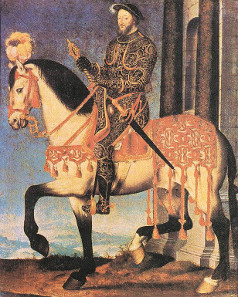Human faces, part 37: Francis I, “Traitor of Christendom”
courtesy of the MoneyMuseum, Zurich
translated by Teresa Teklic
Why was the human head the motif on coins for centuries, no, for millennia? And why did that change in the last 200 years? Ursula Kampmann is looking for answers to these questions in her book “Menschengesichter” (“Human faces”), from which the texts in this series are taken.
Francis I of France (1515-1547). Testone, Lyon, 1543-1547. Armour-clad bust of the King with crown, frontal view, head to the right. Rev. Crowned fleur-de-lis coat of arms. © MoneyMuseum, Zurich.
“Not ours, but thine be the honour, o Lord,” is the motto that Francis I, King of France, in slightly different words quotes on the reverse of our coin.
The motto, like the legend on the obverse, which proclaims Francis I King of France by the grace of God, seems to point to the religious devotion of the French ruler to his Christian God. And yet, Francis was the first to divide the Christians in his battle against the Turks, the first “modern” politician, who gave preference to national concerns over religious differences.
François Clouet, equestrian portrait of Francis I, 1540. Source: Wikicommons.
Viewed from a contemporary perspective, his political strategy was plausible. France was practically locked by Habsburg territories: in the south-west, Charles V ruled as King of Spain, in the north as Lord of the Netherlands, in the East as Holy Roman Emperor and in the south as King of Sicily. For the ambitious Francis, this situation was his worst nightmare. He needed to find strong allies to break free from this suffocating geo-political embrace.
Suleiman I, called the Magnificent, Sultan of the Ottoman Empire, around 1530. Source: Wikicommons.
Only a great ruler was up to this task and this ruler’s empire was in the orient: Suleiman the Magnificent. The sultan had his own problems with the House of Habsburg. After he believed to have won the rule over Hungary in the Battle of Mohacs in 1526, Habsburg claimed the succession of the Hungarian king killed in battle and thus established itself in direct opposition to the Ottoman Empire. Although the first Turk siege of Vienna in 1529 failed, Suleiman continued to pose a danger and Francis I took advantage of that. He made a contract with Hayreddin Barbarossa, the “King of Algiers”, a pirate who collaborated with Suleiman. Hayreddin repeatedly lent Francis parts of his fleet to attack the coasts of Italy – attacks which were generally unsuccessful. The delegation which Francis I sent to Suleiman’s court in 1535 remained equally unsuccessful.
The only one who actually profited from this situation was Charles V. As a propaganda campaign, he staged a battle against the “Traitor of Christendom” and successfully convinced Henry III of England to join him in his war against Francis. The imperial army had almost reached the gates of Paris when the French king surrendered and agreed to a contract with Charles V. One of the many concessions he was forced to make was to provide 10,000 foot soldiers and 600 men of heavy cavalry, should it come to a crusade against the Turks. Thus, the first political alliance against Habsburg was, even if indirectly, ended by religious dissent.
In Henry VIII we find yet another ruler who breaks with the Catholic Church. And that only because he wants to divorce his queen at any price …
You can find all episodes in the series here.
A German edition of the book “Menschengesichter” is available in print and as ebook on the site of the Conzett Verlag.












